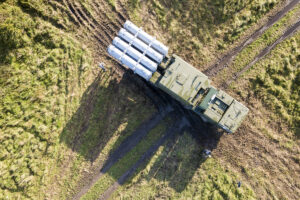On November 16, 2021, the Stimson Center convened the fourth virtual meeting of the U.S.-Russia Military-to-Military Dialogue. The dialogue brings together retired American and Russian senior military officers to discuss and explore avenues for military-to-military cooperation between the United States and Russia on pressing security and strategic issues.
American participants of this meeting of the dialogue included General (ret.) George W. Casey, General (ret.) Curtis M. Scaparrotti, Ambassador Karl W. Eikenberry and General (ret.) John P. Abizaid. Russian participants included Lieutenant General (ret.) Evgeny P. Buzhinsky, Major General (ret.) Vladimir Z. Dvorkin, Colonel General (ret.) Viktor I. Yesin, and Major General (ret.) Pavel S. Zolotarev. Several American and Russian experts participated in the dialogue as observers.
Stimson President and CEO Brian Finlay opened the meeting, highlighting that the dialogue aims to build trust between the military communities, with an ultimate goal of avoiding misunderstanding and miscalculation between the U.S. and Russia. The meeting sessions were moderated by Stimson senior staff members: Bruce McConnell, Vladimir Ivanov and James Siebens.
A major topic of discussion focused on trigger factors that could incite an inadvertent conflict between the two countries, and some practices that would reduce the possibility of military escalation. Participants also exchanged views on possible policy mechanisms that could contribute to reducing military confrontation risk and stabilize bilateral relations, and addressed the role of Track 2 dialogues in helping put such mechanisms in place.
Participants highlighted the need for enhanced communication and transparency between the two countries, both on official and non-official levels, as one method that can reduce the likelihood of a military conflict. They emphasized the fact that talks between the U.S. and Russian leadership resumed recently, and expressed hope that there will be more official and Track 2 contacts between the two sides.
Assessment was made of the main sources of military conflict escalation risks, particularly regional tensions, NATO-Russia tensions, deployment of short- and medium-range missiles in Europe, the military use of cyber technology, and other issues. Participants agreed that the greatest threat is currently coming from regional conflict areas, mentioning the situation in Ukraine, the Black Sea, the Eastern Mediterranean, Poland-Belarus border and other places, where Russia, U.S. and their allies have their military forces in close proximity and where there is a risk of conflict originating in a third country. They also spoke about the dangers of nuclear and missile programs of North Korea and Iran as well as about the destabilizing impact of cyber technologies and new types of warfare development.
Suggestions resulting from the discussion included:
- Restore and enhance mechanisms that would boost mutual understanding, transparency and reduce the risk of miscalculation on the ground. Regular contacts between the two militaries (expanded to mid-level and regional commanders), notifying each other about one’s intentions and threat perceptions, and observing each other’s military exercises are some of the examples.
- Review military doctrines to include provisions that would prevent escalation and rule out the first nuclear strike.
- Revive and revise arms control treaties and adjust them according to current realities, including regulations of cyber domain and the new types of weapons
Participants also explored prospects for expanding the Stimson-led bilateral Track 2 Military-to-Military dialogue and make it more impactful through outreach to policy-making, academic and private sector expert communities.
The U.S.-Russia Military-to-Military dialogue is made possible by the generous support of Carnegie Corporation of New York. The project was initiated by the EastWest Institute in 2020 and transferred to the Stimson Center in 2021.


